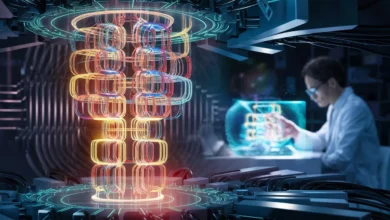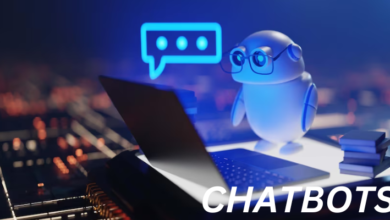How AI-powered Chat Boxes:Transforming Customer Service Interactions

Welcome to a new era of customer service encounters! The days of confusing phone menus, impersonal support workers, and lengthy wait times for holds are long gone. Chat boxes have taken center stage in altering how businesses engage with their customers, thanks to the potential of artificial intelligence (AI). In this blog article, we will dive into the world of AI-powered chat boxes and investigate how they are transforming customer support interactions as we know them. Prepare to experience unprecedented levels of productivity, customization, and contentment for both customers and companies!
Table of Contents
ToggleIntroduction to AI-powered Chat Boxes
With the advancement of technology, businesses are continuously exploring new and innovative methods to improve their customer service encounters. AI-powered chat bubbles are one such technology that has attracted a lot of interest recently. These chat windows, also known as chatbots, use artificial intelligence to mimic human communication and deliver automatic solutions to consumer requests.
AI-powered chat boxes, which offer real-time support, round-the-clock accessibility, and customized experiences, have completely changed how businesses engage with their clientele. Chatbots facilitate immediate communication and speedy problem-solving, in contrast to conventional communication channels like phone calls and emails, where clients frequently face lengthy wait times and delayed responses.
AI’s advantages for customer service
Chat boxes with AI capabilities are fast emerging as a useful tool for customer support conversations. With the ability to learn and adapt, artificial intelligence (AI) technology is transforming old methods of customer service into more efficient and personalized experiences.
We will explore the particular advantages of AI in customer service and how it is transforming the sector in this section.
1.Increased Productivity:
One of the key advantages of employing AI in customer support is its capacity to handle massive numbers of requests concurrently, without any delay or human error. Customers will be more satisfied and devoted as a result of being able to fix their problems far more quickly. Furthermore, AI technology is able to operate around the clock, offering clients in various time zones round-the-clock assistance. As a result, wait times are shortened and customer service operations are generally more efficient.
2.Customized Exchanges:
With AI-powered chat boxes, businesses can deliver a more tailored experience to their clients by evaluating data from previous encounters. AI algorithms are able to offer customized answers and suggestions to specific queries by comprehending the preferences and behavior patterns of its customers. Customers feel appreciated and understood when they receive this level of personalization, which raises their level of satisfaction with the entire experience.
3.Cost-effectiveness:
Incorporating AI technology into customer service operations also promises significant cost benefits for firms in the long run. By utilizing automated responses to manage routine questions and duties, businesses can lower their personnel expenses without sacrificing excellent customer service. Furthermore, as AI develops over time, it gets better at managing complicated activities, which results in even more cost savings and increased productivity.
4.More Accurate Customer Data
Businesses can also learn a great deal about the preferences and behavior of their customers thanks to AI technology. Businesses can gain a more accurate understanding of the requirements and pain areas of their customers by monitoring interactions and analyzing data. This information can then be used to make informed decisions for product or service upgrades, personalized marketing efforts, and overall business plans.
5.Support in Multiple Languages:
Businesses may serve a worldwide clientele without investing in multilingual support staff by using AI-powered chat boxes that can be trained to communicate in several languages. In addition to saving money, this enhances the experience for non-native speakers who might feel more at ease conversing in their mother tongue.
6.Diminished Human Error
Unlike human agents, AI-powered chat boxes are not prone to human error such as weariness or emotional biases. They give consistent and correct responses every time, maintaining a high level of quality in customer service engagements.
Workings of AI Chat Boxes
The usefulness and efficiency of chat boxes driven by AI are influenced by a number of aspects. This section will examine the operation of these cutting-edge tools and the reasons behind their rising popularity in customer service encounters.
1.NLP, or natural language processing,
The ability of AI chat boxes to comprehend and process natural language is one of its main features. Artificial intelligence’s Natural Language Processing (NLP) technology allows machines to understand, produce, and analyze human language. This implies that AI chatbots can understand several languages, slang, complex sentences, and errors. These chat boxes can “learn” from past interactions with clients using sophisticated natural language processing algorithms, so that over time, their responses get better.
2.Artificial Intelligence:
Additionally, AI chat boxes make use of machine learning strategies to enhance their customer interaction capabilities over time. These systems can evolve and draw connections between words or phrases that are related but may not have the same meaning thanks to ongoing exposure to fresh data sets and user feedback. As a result, the chat box can now respond with greater accuracy depending on context as opposed to just keyword matching.
3.Pre-established variables
AI chat boxes are programmed with pre-defined variables, such as frequently asked questions (FAQs), product information, and specific keywords linked to the business’s goods or services, to enable a smooth discussion flow with clients. When a consumer interacts with the chat box, these variables serve as a knowledge base from which information can be pulled.
Customization and Human-like Communication
AI-powered chat boxes are transforming customer service encounters through human-like interactions and personalization. Artificial intelligence has advanced to the point where chat boxes have features that allow them to comprehend customer needs, preferences, and emotions more than ever before.
The ability of AI-powered chat boxes to customize customer interactions is one of their main advantages. These smart systems are able to compile information from several sources, including past purchases, browsing patterns, and customer profiles, in order to provide each user with a customized experience. This enables the chat box to customize its recommendations and responses according to the individual needs and preferences of the user.
AI-powered chat boxes are excellent at delivering human-like interactions in addition to customisation. These sophisticated systems use natural language processing (NLP) algorithms to interpret and reply to client queries in a conversational manner, in contrast to standard chat bots that follow preset scripts. Customers may now conduct smooth chat chats with the chat box instead of putting up with awkward automatic responses.
Furthermore, AI-powered chat boxes use machine learning techniques to continuously learn and get better. Over time, as they engage with more clients, they grow more knowledgeable, precise, and adept at interpreting purpose and context. Customers experience a more humane contact as a result, feeling more like they are speaking with a real person rather than a computer that has been programmed.
Enhanced Effectiveness and Financial Savings
AI-powered chatbots are revolutionizing customer service by increasing productivity and cutting expenses. The development of artificial intelligence technology has led to chat boxes being more advanced and able to respond to a variety of consumer questions.
The increased efficiency of these chat boxes is one of the main ways that they are transforming customer support interactions. Customers expect quick and effective responses when they contact a business with a question or for support. Conventional customer assistance techniques, including sending an email or phoning a business’ support line, frequently lead to protracted wait periods and delays in receiving a resolution.
Chat boxes with AI capabilities, on the other hand, have altered this dynamic by instantly responding to consumer questions. Natural language processing (NLP) methods are used by these chat windows to comprehend and reply to user inquiries. Customers won’t have to wait for a representative to help them now that this is the case. Any time of day or night, they can use the chat box to get rapid assistance.
Additionally, chat boxes with AI capabilities may manage several discussions at once without sacrificing the level of service quality. Compared to traditional customer service systems, where agents might only be able to manage one discussion at a time, this drastically cuts response times.
These chat rooms can also access a plethora of data regarding the goods and services that a firm provides. They may get pertinent information fast and give it to clients instantly. This capability not only increases productivity but also improves the general customer experience by giving clients the impression that their inquiries are being addressed correctly and quickly.
Examples of Successful Implementations in Real Life
Various businesses, such as e-commerce, healthcare, and banking, have widely accepted the use of AI-powered chat boxes in customer support interactions. By utilizing sophisticated machine learning algorithms, these chat boxes have significantly enhanced customer satisfaction and boosted business productivity.
Here are a few actual instances of AI-powered chat boxes being successfully implemented:
- Amazon’s “Alexa” Virtual Assistant: Alexa, the virtual assistant from Amazon, is among the most well-known instances of a chat box driven by AI. Alexa is a feature of the Amazon website that is meant to make consumers’ shopping experience as smooth as possible. It does this by using natural language processing to comprehend and reply to user questions regarding goods and services. Customers may now shop online more quickly and conveniently thanks to this.
- Babylon Health: The usage of AI-powered chat boxes has significantly improved customer support interactions in the healthcare sector as well. A UK-based digital health business named Babylon Health has created an app that lets users communicate with “Babylon,” an AI-powered interface. By decreasing wait times for doctor appointments and increasing accessibility to healthcare, the chat box assists patients in evaluating their symptoms and offers guidance on obtaining more medical support if necessary.
- “Erica” from Bank of America: Another industry that has effectively used AI-powered chat boxes into its customer support operations is finance. Bank of America’s virtual assistant, Erica, employs natural language processing and predictive analytics to help consumers manage their accounts through voice or text instructions. It can help with things like making payment plans, monitoring account balances, and even giving financial guidance.
- Starbucks’ “My Starbucks Barista”: The coffee giant introduced “My Starbucks Barista,” an AI-powered chat window, in 2017. Customers can use voice or text instructions to order and pay for their coffee using the chat box, which is accessible through the company’s mobile app. Additionally, it keeps track of past orders and makes menu item recommendations based on past ordering behavior.
- “BlueBot” from KLM Airlines: KLM Airlines uses chatbots driven by artificial intelligence to improve the travel and reservation experience for its customers. Customers can access their virtual assistant, BlueBot, via Facebook Messenger. BlueBot offers individualized flight recommendations, real-time flight status information, and help with changing or canceling reservations.
Taking Care of Issues and Restrictions
Despite the fact that AI-powered chat boxes have become increasingly popular in the customer service sector due to their effectiveness and efficiency, certain issues and restrictions still need to be resolved. We will examine these issues in this section and offer suggestions for how companies might resolve them.
1.Absence of Human Interaction
The absence of a human element in consumer interactions is one of the primary issues with AI-powered chat windows. This can be a significant disadvantage for companies that value developing a human rapport with their clients. Consumers who deal with a machine rather than a live person could become irritated or unsatisfied.
Businesses must strike a balance between deploying AI-powered chat boxes and human agents in order to allay this worry. These chat boxes work incredibly well for basic questions and activities, but they might not be appropriate for more delicate or complicated problems that call for emotional intelligence and sensitivity. While letting the chat boxes handle routine tasks, businesses should think about training their human agents to handle such cases, freeing them up to concentrate on developing personal relationships with customers.
2.Dependability and Precision
The correctness and dependability of AI-powered chat boxes in comprehending consumer inquiries and responding appropriately is another issue. These systems’ reliance on algorithms means that there’s always a chance of misinterpretation or inaccurate information being provided, which might annoy users.
AI’s Role in Customer Service Future
The application of AI to customer service is a promising and quickly developing field. Businesses are always looking for methods to improve the customer experience and streamline their operations as a result of the rapid advancement of technology. Artificial Intelligence (AI) has become a revolutionary tool for customer service interactions as a result of this.
AI’s capacity to automate repetitive operations frees up human agents to focus on more complicated issues, which is one of the biggest benefits AI delivers to customer service. Businesses benefit from reduced costs, more efficiency, and quicker reaction times as a result.
Chat boxes driven by AI are not only automated; they can also learn from previous client encounters. These chat windows have the ability to customize responses based on the requirements and preferences of each user by evaluating data from past exchanges. Customers get a more tailored experience as a result, and their general level of satisfaction rises as well.
The ability of AI to process natural language (NLP) is another important feature for customer support. Chatbots can now more precisely comprehend and interpret human language thanks to natural language processing (NLP). This implies that clients may communicate with these chat boxes exactly like they would with another human being, without having to utilize sophisticated query patterns or keywords.
AI-powered chat boxes can now handle even more complicated queries, like making product recommendations or diagnosing technical problems, thanks to this improvement in NLP technology. This not only offers clients a flawless support experience, but it also makes problem solving quicker and lessens the need for escalation.
Conclusion
Efficiency and customer satisfaction have significantly increased with the introduction of AI-powered chat boxes in customer support engagements. These clever technologies have demonstrated a great deal of promise in recognizing and meeting customer wants, leading to more rapid reaction times and customized solutions. We can only anticipate these chat boxes become smarter and more effective as companies use this technology more and more, which will improve the overall consumer experience. It’s an exciting moment for customer support interactions in the future, with chat windows driven by AI setting the standard.
FAQs about AI-powered Chat Boxes in Customer Service:
What is an AI-powered chat box?
An AI-powered chat box, also known as a chatbot, is a technology-driven interface that uses artificial intelligence (AI) to mimic human communication. These chat boxes are designed to provide real-time support, automate responses, and offer personalized interactions to users seeking assistance or information.
How do AI-powered chat boxes improve customer service efficiency?
AI-powered chat boxes enhance efficiency by handling a large volume of customer requests simultaneously, providing immediate responses, and operating 24/7. Their ability to learn from interactions, offer personalized solutions, and automate routine tasks results in increased productivity, shorter wait times, and overall improved customer service operations.
Can AI-powered chat boxes understand different languages and communication styles?
Yes, AI-powered chat boxes are equipped with Natural Language Processing (NLP) technology, allowing them to understand and respond to various languages, slang, and complex sentences. They can adapt to different communication styles and continuously improve their language understanding through machine learning.
What industries have successfully implemented AI-powered chat boxes?
Various industries, including e-commerce, healthcare, banking, and hospitality, have successfully implemented AI-powered chat boxes. Examples include Amazon’s Alexa in e-commerce, Babylon Health in healthcare, Bank of America’s Erica in finance, and KLM Airlines’ BlueBot in the travel industry.
Are there any limitations or concerns with AI-powered chat boxes?
While AI-powered chat boxes offer numerous benefits, concerns include the lack of human interaction for more sensitive issues and the potential for inaccuracies in responses due to reliance on algorithms. Striking a balance between AI-driven automation and human intervention is essential to address these concerns and provide a holistic customer service experience.




